Overview of the Nervous System: Structure, Function, and Cell Types
1/85
There's no tags or description
Looks like no tags are added yet.
Name | Mastery | Learn | Test | Matching | Spaced |
|---|
No study sessions yet.
86 Terms
What are the primary functions of the nervous system?
Controls perception and experience of the world, directs voluntary movement, serves as the seat of consciousness, personality, learning, and memory, and regulates aspects of homeostasis.
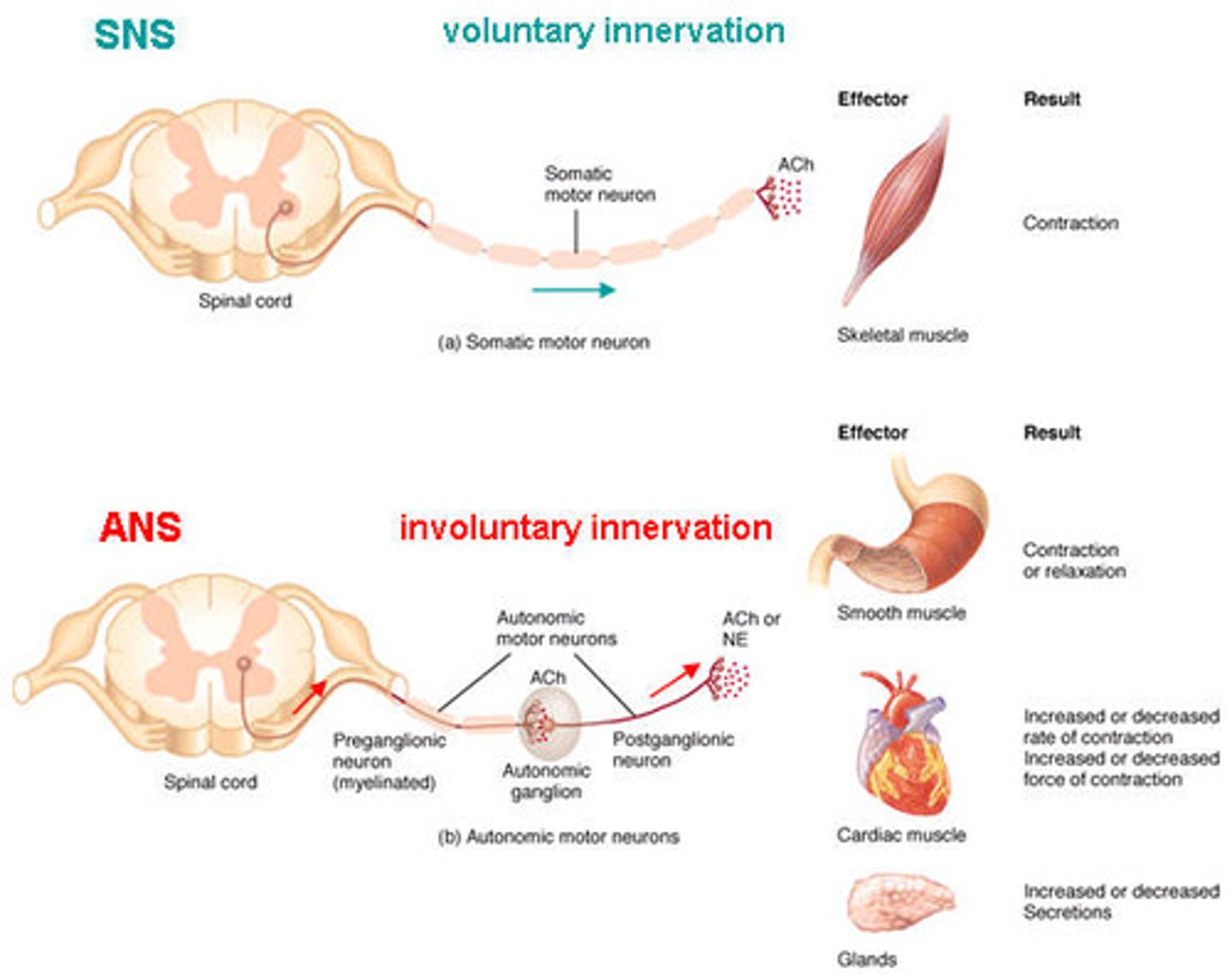
What aspects of homeostasis does the nervous system regulate?
Respiratory rate, blood pressure, body temperature, sleep/wake cycle, and blood pH.
What are the two main anatomical divisions of the nervous system?
Central nervous system (CNS) and peripheral nervous system (PNS).
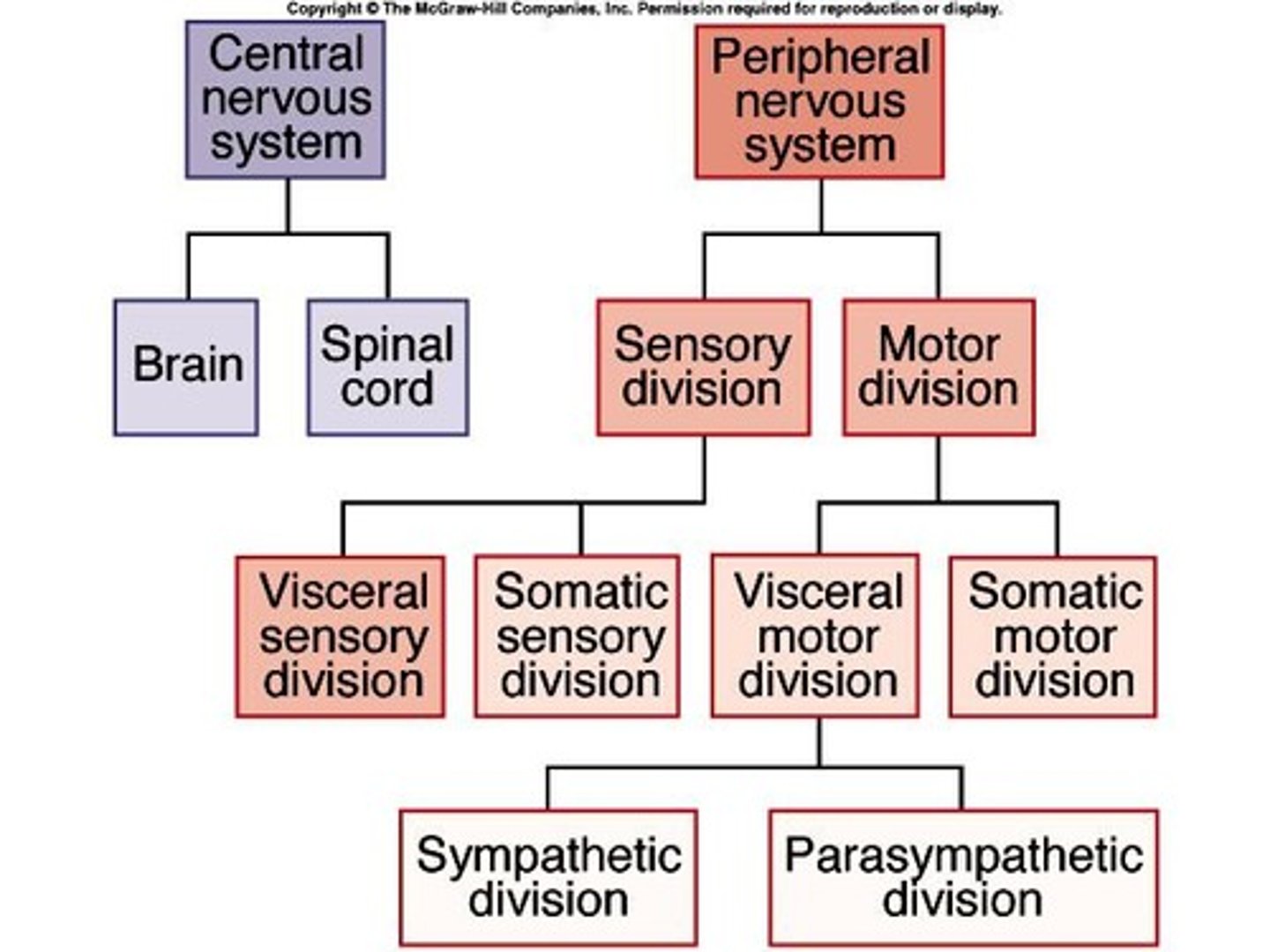
What does the central nervous system (CNS) consist of?
The brain and spinal cord.
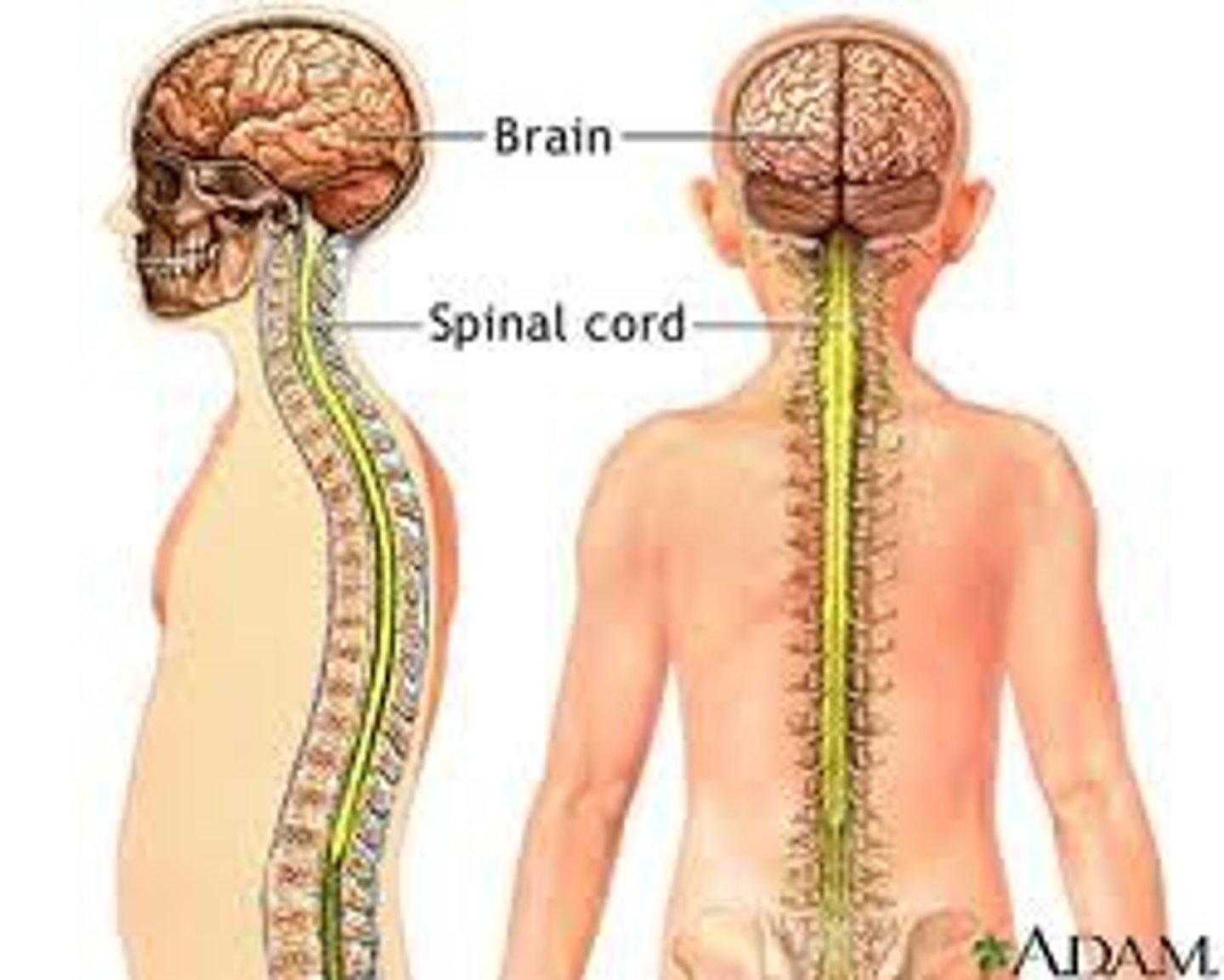
How is the brain protected?
By the bones of the skull.
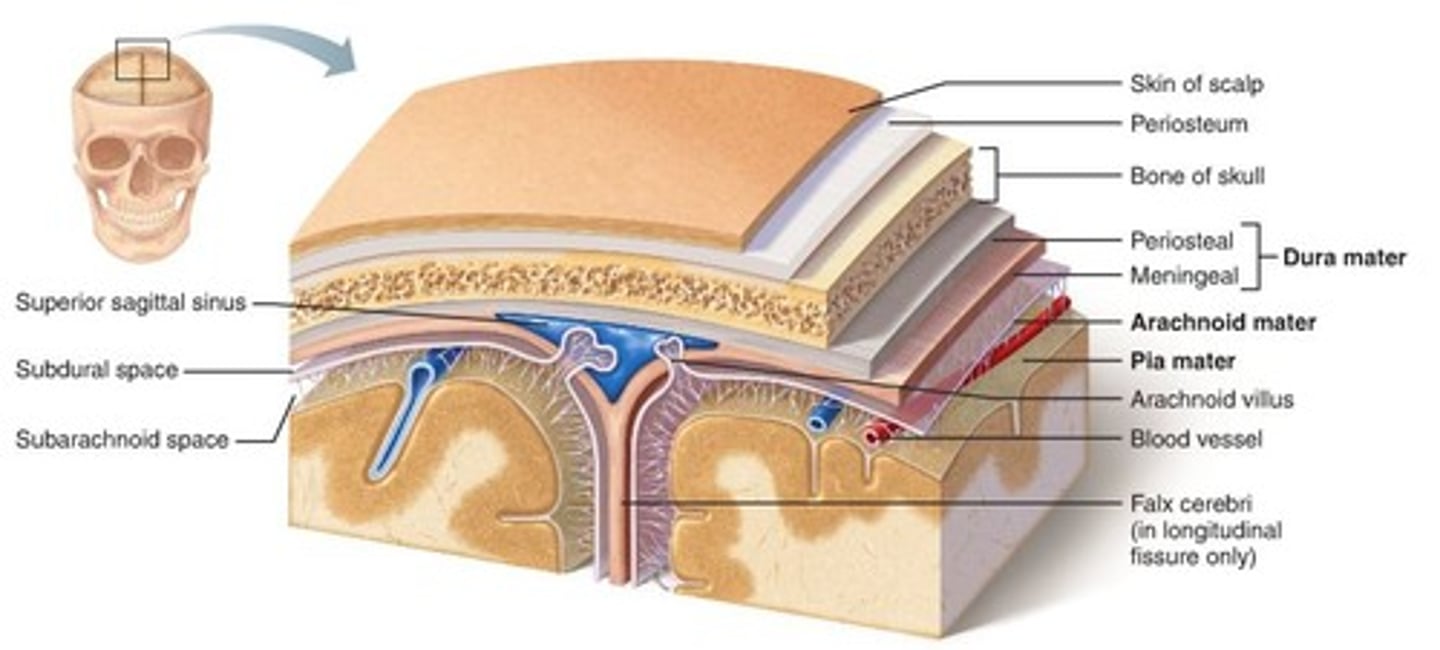
What is the function of the spinal cord?
Enables communication between the brain and most of the body below the head and neck.
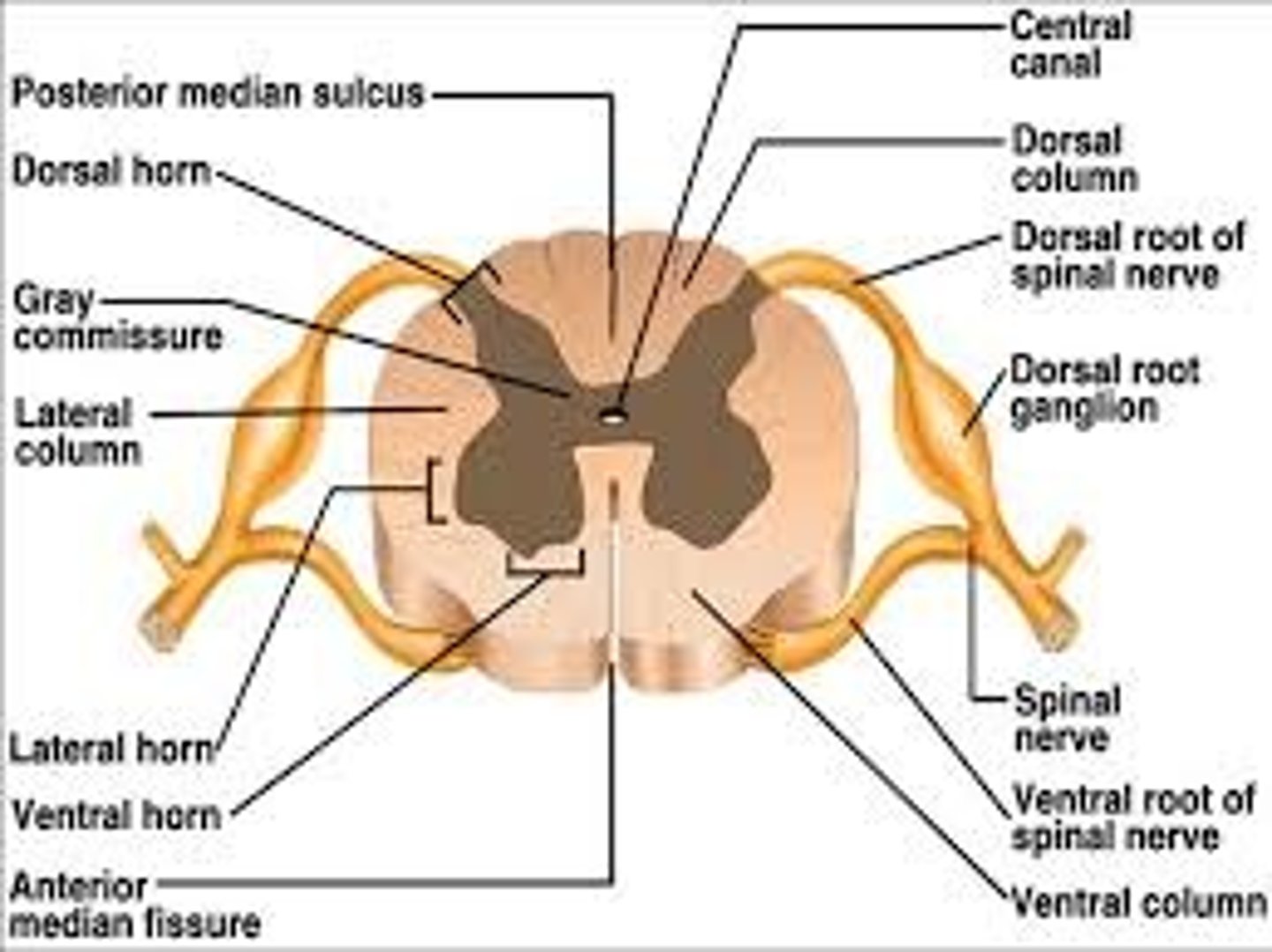
What does the peripheral nervous system (PNS) consist of?
All nerves in the body outside the protection of the skull and vertebral column.
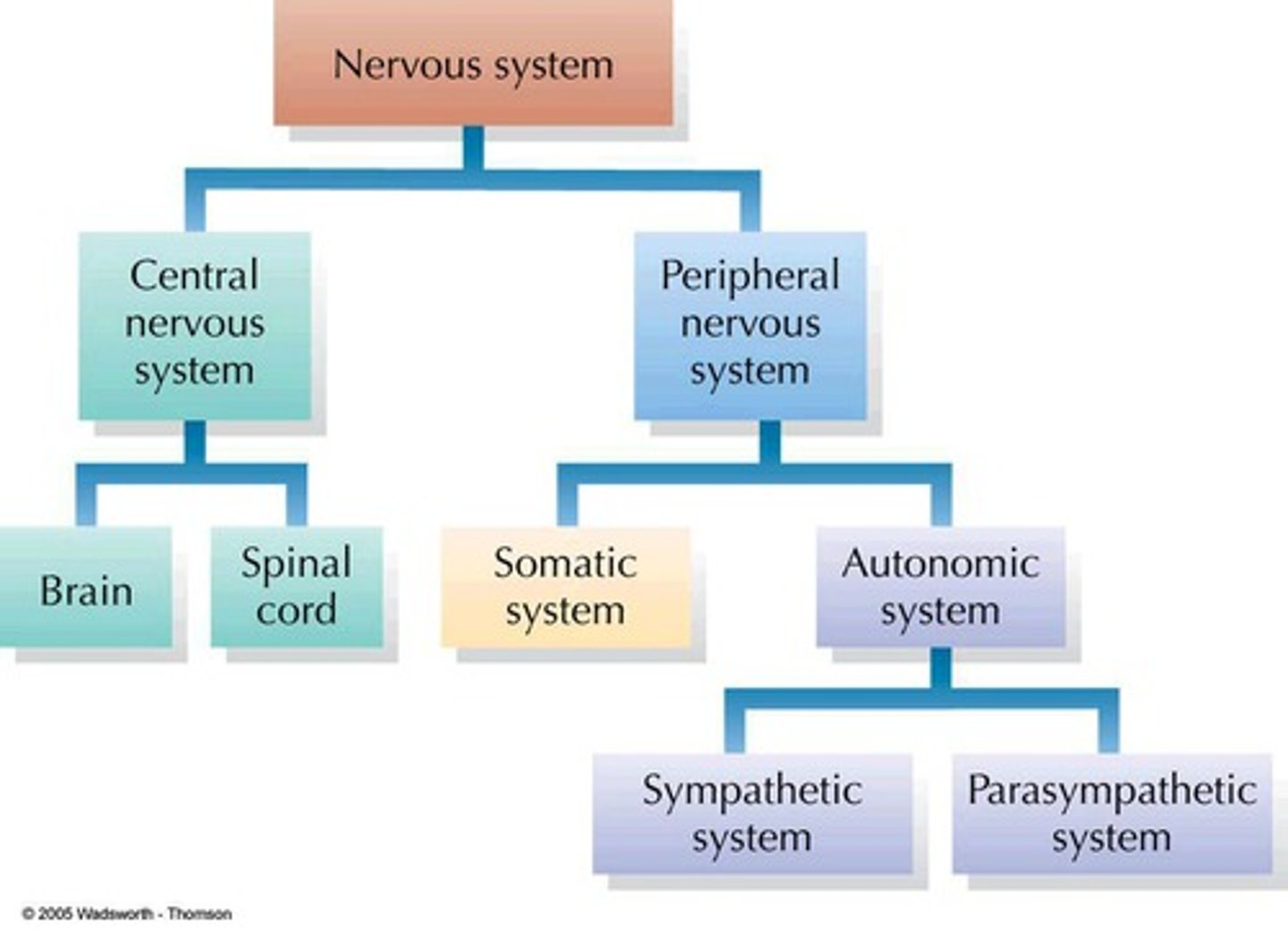
What are cranial nerves?
12 pairs of nerves traveling back to or from the brain.
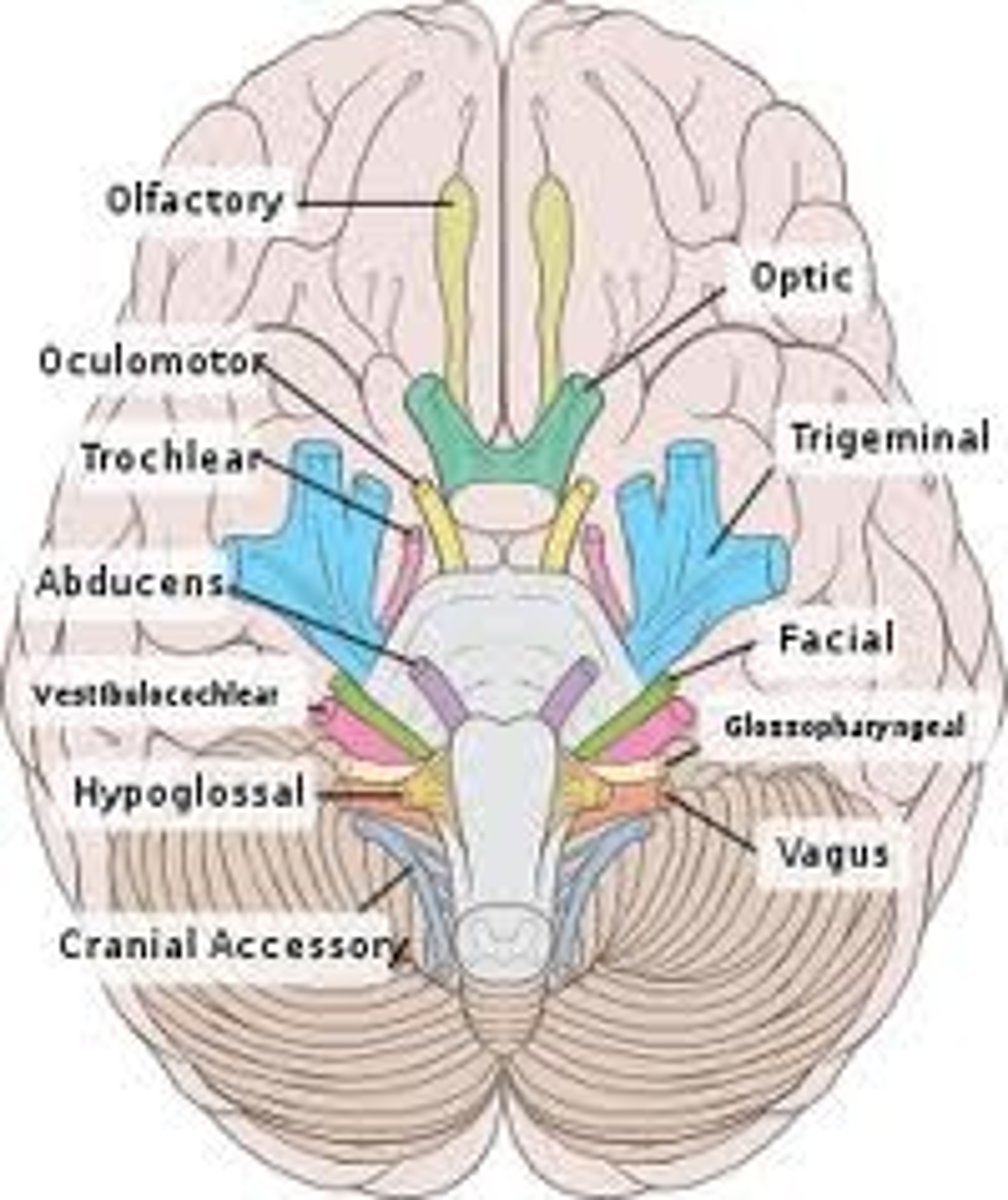
What are spinal nerves?
31 pairs of nerves traveling back to or from the spinal cord.
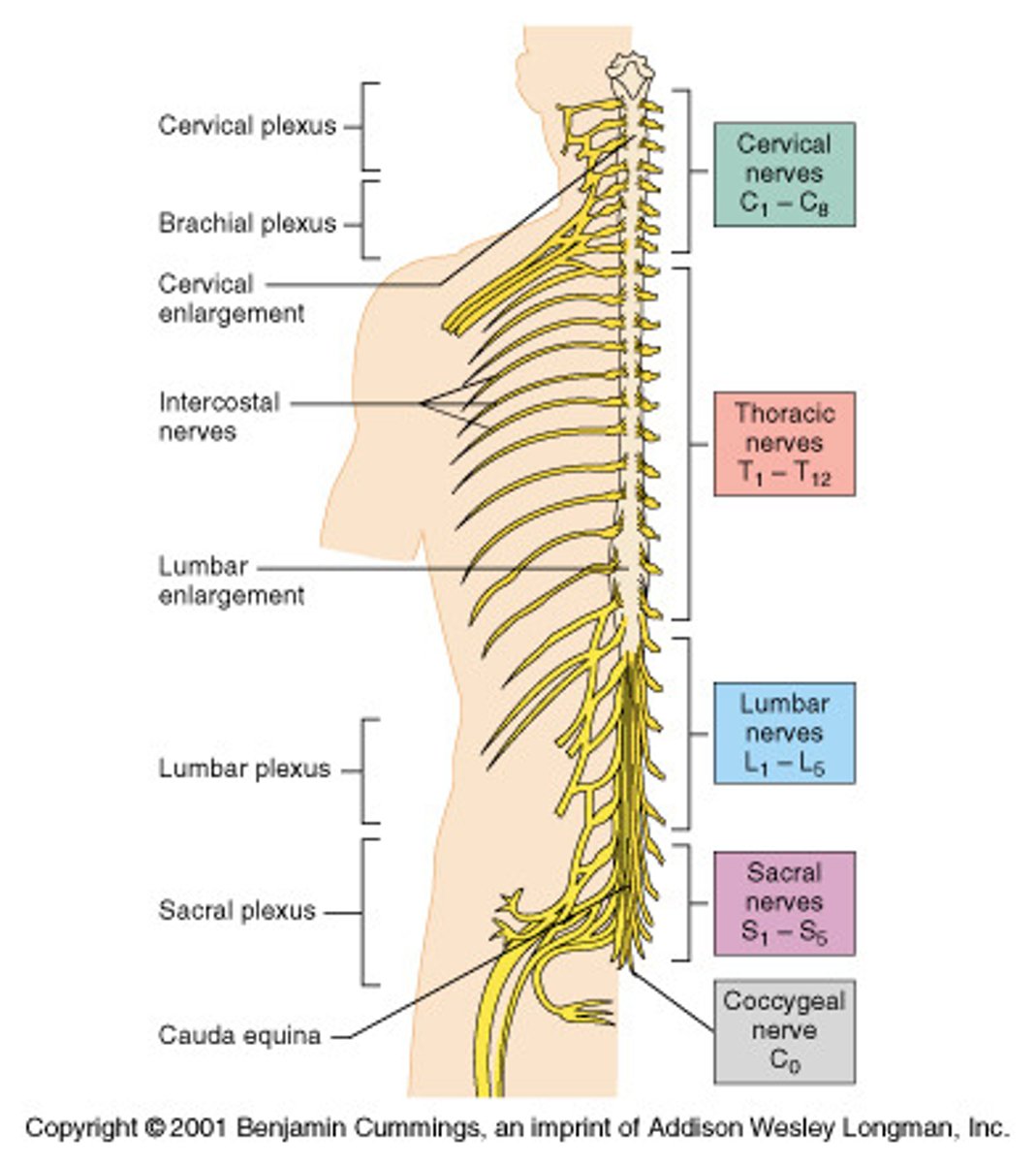
What are the three functional categories of the nervous system?
Sensory, integrative, and motor functions.
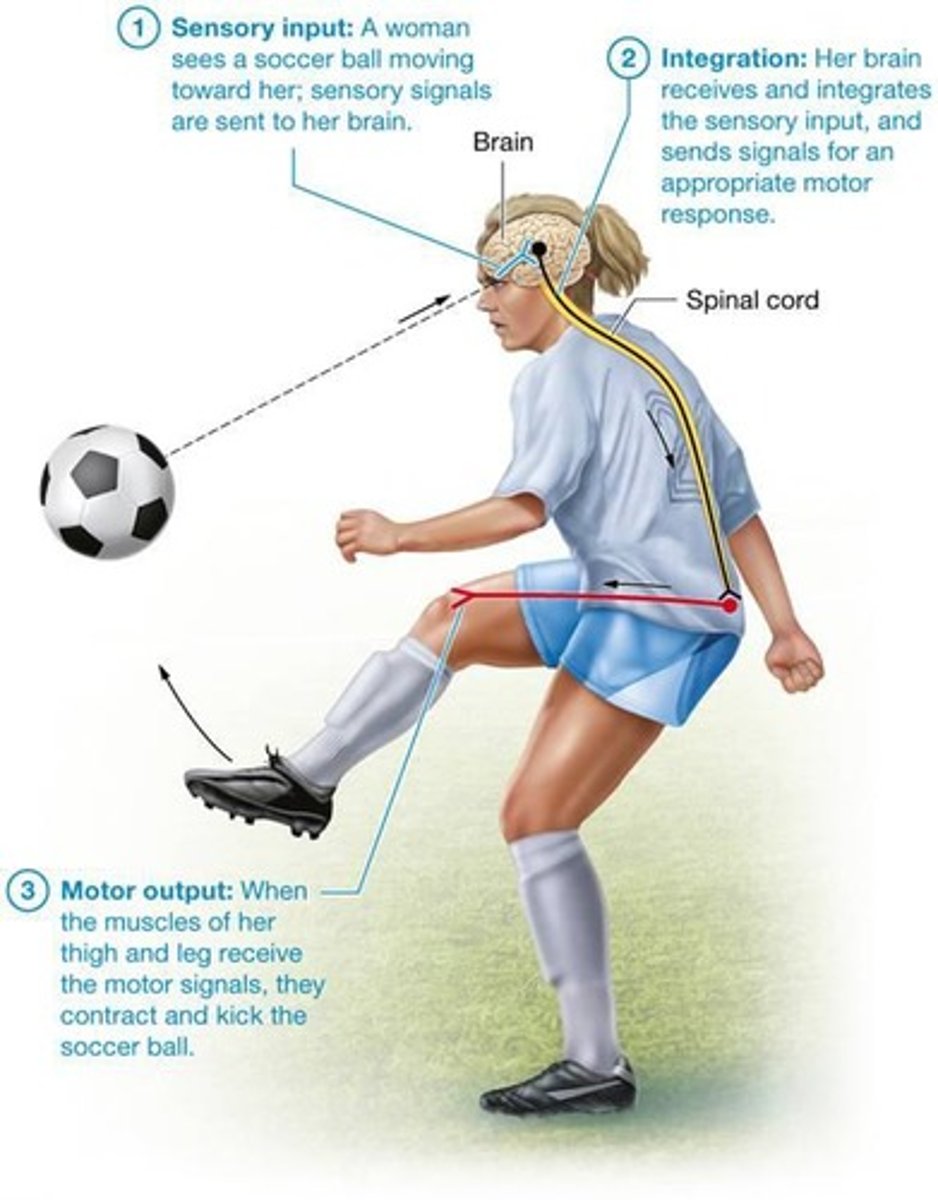
What is the role of sensory functions in the nervous system?
To gather information about the internal and external environments of the body.
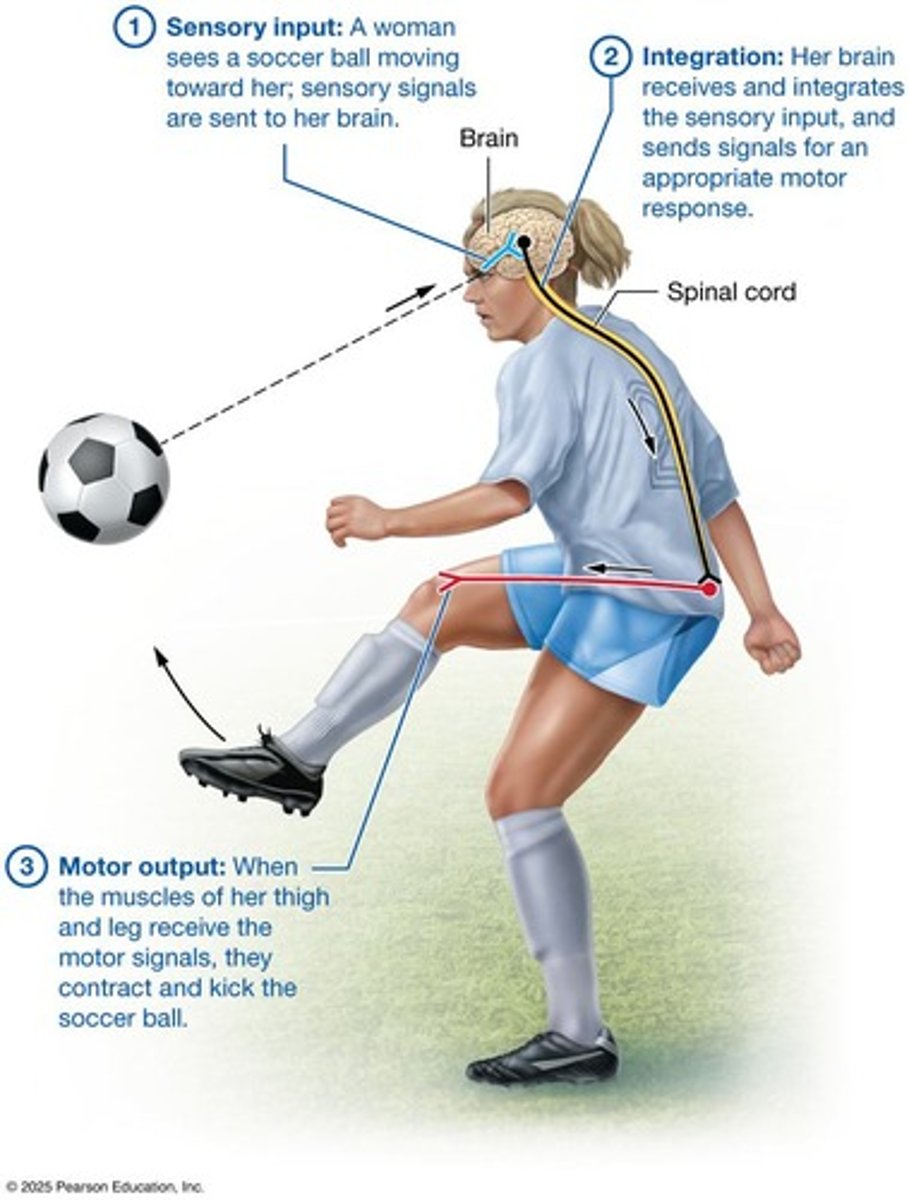
What are the two divisions of the sensory (afferent) division of the PNS?
Somatic sensory division and visceral sensory division.
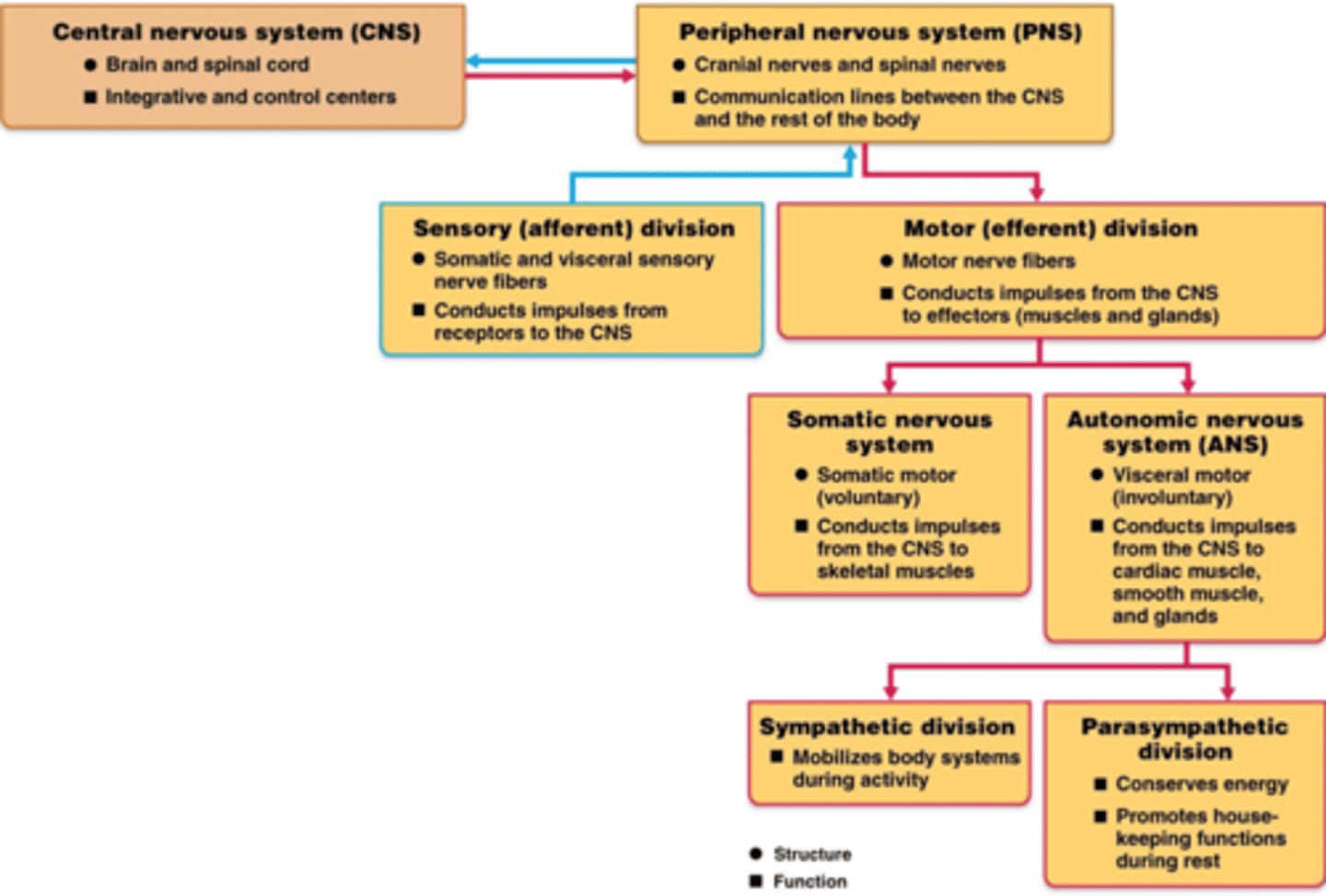
What does the somatic sensory division consist of?
Neurons that carry signals from skeletal muscles, bones, joints, skin, and special senses (vision, hearing, taste, smell, balance).
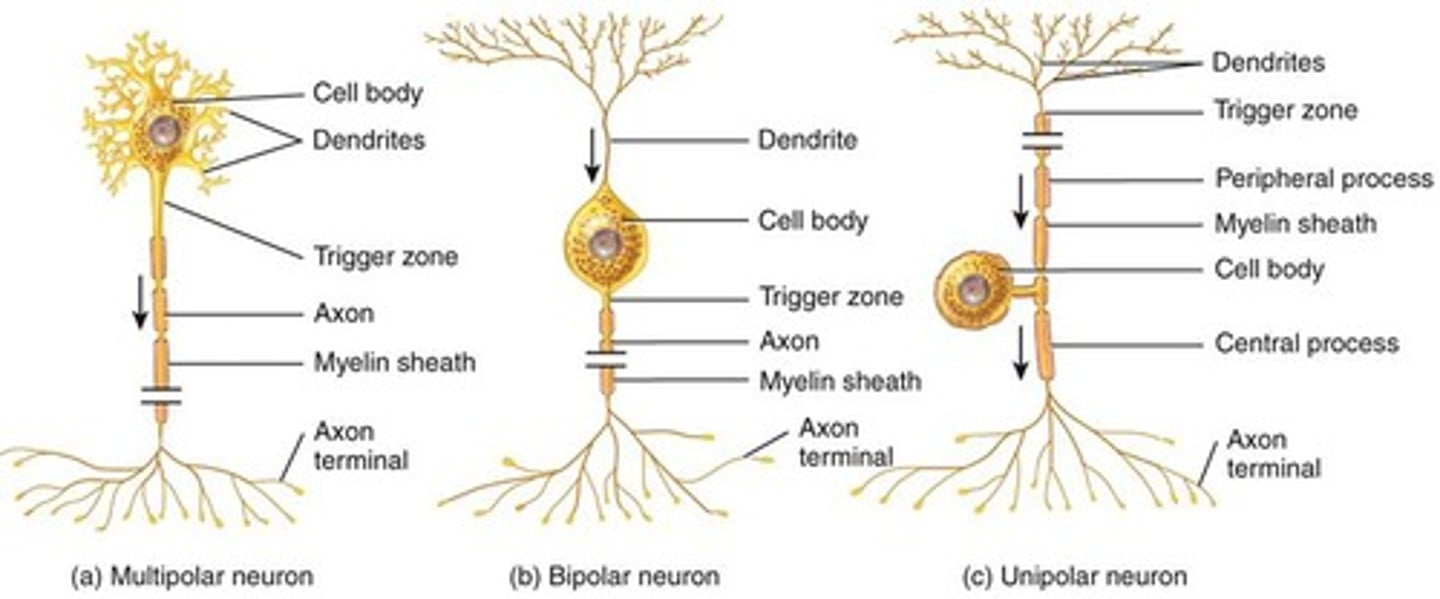
What does the visceral sensory division consist of?
Neurons that transmit signals from internal organs such as the heart, lungs, stomach, kidneys, and urinary bladder.
What do integrative functions of the nervous system do?
Analyze and interpret incoming sensory information and determine an appropriate response.
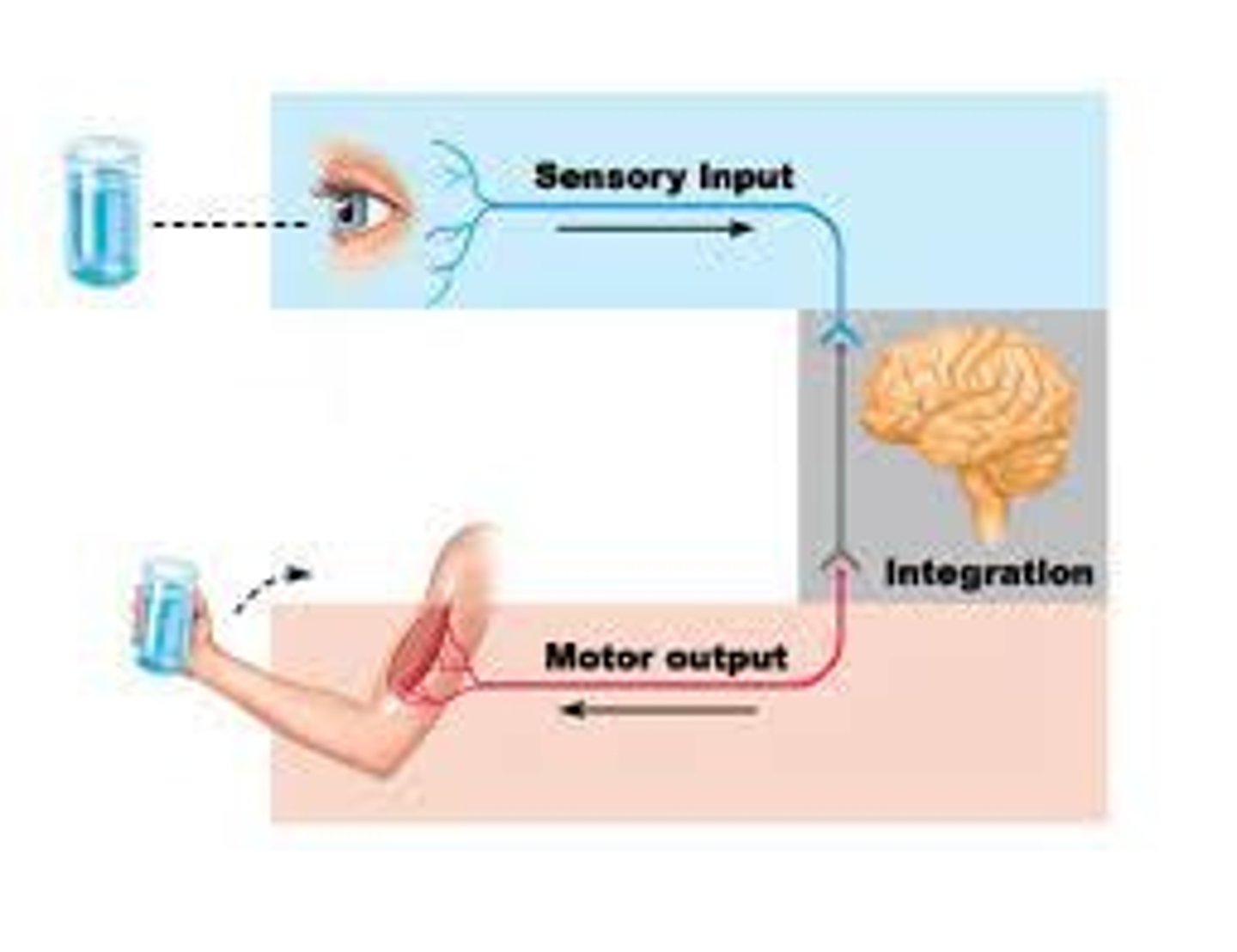
What percentage of integrated sensory information is typically disregarded by the CNS?
99%.
What happens to the remaining sensory stimuli that the CNS responds to?
It generally leads to a motor response.
What are the two main subdivisions of the motor functions in the nervous system?
Somatic and autonomic divisions.
What is the role of the motor or efferent division of the PNS?
It performs motor functions by carrying signals from the brain and spinal cord to effectors.
What type of muscles does the somatic motor division control?
Skeletal muscles, under voluntary control.
What is the autonomic nervous system (ANS) responsible for?
It carries signals to thoracic and abdominal viscera, regulating involuntary functions like gland secretion and muscle contraction.
What are effectors in the context of the nervous system?
Organs that carry out the effects of the nervous system.
What are the three main parts of a neuron?
Cell body (soma), dendrites, and axon.
What is the primary function of the cell body (soma) of a neuron?
It is the most metabolically active region, manufacturing all proteins needed for the neuron.
What organelles support the high metabolic activity of a neuron's cell body?
Free ribosomes, rough endoplasmic reticulum (RER), Golgi apparatus, and mitochondria.
What are Nissl bodies?
They are rough endoplasmic reticulum (RER) structures visible under a microscope, involved in protein synthesis.
What is the function of the cytoskeleton in a neuron?
It provides structural support and facilitates chemical transportation between the cell body and axon.
What are neurofibrils and their role in neurons?
They are composed of intermediate filaments that provide structural support extending into neuron processes.
What are dendrites and their function?
Short, branched processes that receive input from other neurons and transmit it toward the cell body.
What do axons do in a neuron?
They transmit electrical impulses away from the cell body to other cells.
How do neurons communicate with other cells?
Through their processes, which include dendrites and axons.
What is the significance of mitochondria in neurons?
They supply the energy required for the high metabolic activity of the neuron.
What is the difference between voluntary and involuntary motor divisions?
Voluntary motor division controls skeletal muscles, while involuntary motor division (ANS) regulates smooth and cardiac muscles.
What is the primary role of the autonomic nervous system?
To maintain homeostasis of the body's internal environment.
What types of muscle contractions does the autonomic nervous system regulate?
Contraction of smooth muscle and cardiac muscle.
What is the function of the Golgi apparatus in the neuron?
It is involved in vesicular transport and processing of proteins.
What is the role of free ribosomes in the neuron?
They are involved in protein synthesis necessary for the neuron's functions.
What is the primary characteristic of neurons?
They are excitable cells responsible for sending and receiving signals in the form of action potentials.
What is the significance of the processes in a neuron?
They allow for communication between neurons and other cells.
What is the primary function of a neuron's axon?
To generate and conduct action potentials.
What is the axon hillock?
The region where the axon originates from the cell body.
What are axon collaterals?
Branches that extend from the main axon.
What are telodendria?
Small branches that arise from the axon and axon collaterals near their ends.
What are axon terminals or synaptic bulbs?
Components that communicate with a target cell, arising from telodendria.
What is the axolemma?
The plasma membrane that surrounds the axon and its cytoplasm (axoplasm).
What is slow axonal transport?
A transport mechanism that moves substances like cytoskeleton proteins from the cell body through the axon at a rate of 1-3 mm/day.
What is fast axonal transport?
A transport mechanism that requires motor proteins and consumes ATP, allowing vesicles and organelles to travel at rates of up to 200 mm/day retrograde and 400 mm/day anterograde.
What is poliomyelitis and how does it affect the CNS?
It is caused by poliovirus, impacting the CNS and spinal cord, potentially resulting in deformity and paralysis.
How does the poliovirus access the CNS?
By entering muscle cells, then passing into motor neurons at the neuromuscular junction and traveling via retrograde axonal transport to the spinal cord.
What are the three main functional regions of neurons?
Receptive region (dendrites and cell body), conducting region (axon), and secretory region (axon terminal).
How are neurons classified structurally?
Into three groups: multipolar neurons, bipolar neurons, and pseudounipolar neurons.
What characterizes multipolar neurons?
They have a single axon and multiple dendrites, making up over 99% of all neurons.
What is unique about bipolar neurons?
They have one axon and one dendrite with a cell body between them, found in the eye and olfactory epithelium.
What defines pseudounipolar neurons?
They have one fused axon that divides into two processes: one carries sensory information to the cell body, and the other carries it to the spinal cord.
What types of sensory information do pseudounipolar neurons carry?
Information related to pain, touch, and pressure.
What is the maximum rate of retrograde transport in fast axonal transport?
200 mm/day.
What is the maximum rate of anterograde transport in fast axonal transport?
400 mm/day.
What viruses can invade the CNS via retrograde axonal transport?
Poliovirus, herpes simplex, and rabies.
What toxins can invade the CNS via retrograde axonal transport?
Tetanus toxin.
What is the role of motor proteins in fast axonal transport?
They facilitate the movement of vesicles and membrane-bound organelles along the axon.
What is the axoplasm?
The cytoplasm within the axon.
What is the significance of axonal transport?
It allows for the movement of essential substances between the cell body and axon terminals.
What are the three functional groups of neurons?
Sensory (afferent) neurons, interneurons (association neurons), and motor (efferent) neurons.
What is the function of sensory neurons?
They carry information toward the CNS; their cell bodies are in the PNS and receive information from sensory receptors.
What types of neuron structures are typically found in sensory neurons?
Sensory neurons are usually pseudounipolar or bipolar.
What is the role of interneurons?
They relay information within the CNS between sensory and motor neurons and make up most of the neurons in the body.
What type of neuron is primarily involved in carrying information away from the CNS?
Motor (efferent) neurons.
What are the main components of the CNS?
Nuclei (clusters of neuron cell bodies) and tracts (bundles of axons).
What are the main components of the PNS?
Ganglia (clusters of neuron cell bodies) and nerves (bundles of axons).
What is the primary function of neuroglia?
They provide structural support and protection for neurons and maintain their environment.
How do neuroglial cells respond to neuron death?
They can divide and fill in the space left behind when a neuron dies.
What are the four types of neuroglial cells found in the CNS?
Astrocytes, oligodendrocytes, microglia, and ependymal cells.
What are the two types of neuroglial cells found in the PNS?
Schwann cells and satellite cells.
What are the functions of astrocytes?
They anchor neurons and blood vessels, facilitate nutrient and gas transport, assist in forming the blood-brain barrier, and repair damaged brain tissue.
What is the role of oligodendrocytes?
They wrap around axons of nearby neurons to form myelin in the CNS.
What is the function of microglia?
They act as phagocytic cells that ingest disease-causing microorganisms, dead neurons, and cellular debris.
What do ependymal cells do?
They line hollow spaces in the CNS and manufacture and circulate cerebrospinal fluid.
What is the function of Schwann cells?
They encircle axons in the PNS to provide myelination.
What is the role of satellite cells in the PNS?
They provide supportive functions surrounding the cell bodies of neurons.
What is the myelin sheath?
It is composed of repeating layers of plasma membrane from Schwann cells in the PNS and oligodendrocytes in the CNS.
What is myelination?
The process of forming a myelin sheath from the plasma membranes of neuroglial cells.
How does myelination affect action potential conduction speed?
Myelinated axons conduct action potentials about 15-20 times faster than unmyelinated axons.
What is neurolemma?
It is found on the outer surface of a myelinated axon in the PNS, composed of the Schwann cell nucleus, organelles, and cytoplasm.
How do oligodendrocytes differ from Schwann cells in terms of myelination?
Oligodendrocytes can myelinate multiple axons in the CNS, while Schwann cells myelinate only one axon in the PNS.
When does myelination begin in the PNS compared to the CNS?
Myelination begins early in fetal development in the PNS and much later in the CNS.
What is a key difference in myelin presence in newborns?
There is very little myelin present in the brain of newborns.